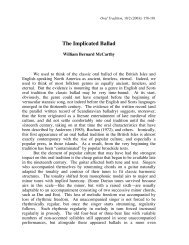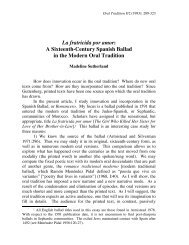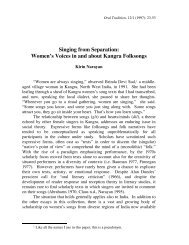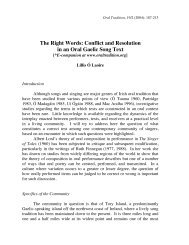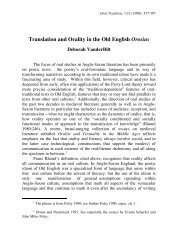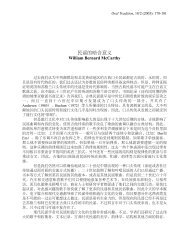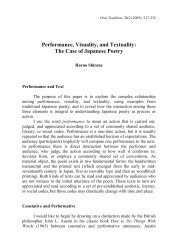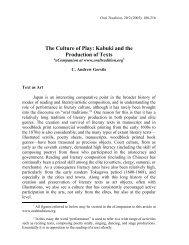Garner and Miller - Oral Tradition Journal
Garner and Miller - Oral Tradition Journal
Garner and Miller - Oral Tradition Journal
Create successful ePaper yourself
Turn your PDF publications into a flip-book with our unique Google optimized e-Paper software.
372 LORI GARNER AND KAYLA MILLER<br />
them” (1890:392). For Underhill, the incantation would have had much the same binding effect,<br />
provided the incantation were recited loudly enough. If a runaway swarm of bees appeared to<br />
settle in response to the performer’s words, the apparent success could indicate ownership.<br />
Further, if we leave open the possibility that certain aspects of human nature are shared by<br />
medieval <strong>and</strong> modern beekeepers, an Anglo-Saxon beekeeper reciting the Wið Ymbe incantation<br />
might have done so without necessarily believing its efficacy at a literal level, just as Grant<br />
Jackson continues to “tang” bees even at the same time that he provides reasons for why it<br />
doesn’t actually “work.”<br />
Concerns of ownership were arguably even more an issue in medieval times than modern.<br />
“Bee-theft” (“beoþeof”) was considered a serious enough crime in the laws of Alfred<br />
(Attenborough 1922:68-69) to be included alongside theft of gold <strong>and</strong> horses (“goldþeof” <strong>and</strong> the<br />
“stodþeof” [ibid., section 9, 2]). Bees were precious as a source of honey, used for mead <strong>and</strong><br />
sweetening, <strong>and</strong> also wax, a by-product of honey-production that could be used for c<strong>and</strong>les <strong>and</strong><br />
sealant. For these <strong>and</strong> other reasons, Spamer logically asserts “that a beekeeper would have been<br />
very concerned about someone stealing his bees” (1978:282) <strong>and</strong> that “the best opportunity for<br />
stealing bees is precisely when they swarm” (283), since they are at their calmest during this<br />
period, their stomachs full of honey <strong>and</strong> their full efforts focused on protecting their queen <strong>and</strong><br />
locating a new home. One of a beekeeper’s first concerns would thus “naturally be to insure that<br />
it would not be stolen” (283). Spamer’s suggestion that the incantation serves as a “countercharm”<br />
against “any possible spell drawing the swarm away” (283) does not preclude the<br />
incantation’s effect on anyone within earshot of the recitation or the effect of the performer’s<br />
voice on the bees’ themselves. As with the other aspects of the remedy, a modern beekeepers’<br />
perspective here serves to complement prior interpretations <strong>and</strong> provide additional levels at<br />
which Wið Ymbe seems to have been operating.<br />
Conclusion<br />
While certainly many aspects of beekeeping have changed between medieval <strong>and</strong> modern<br />
times, the potential desirability of a swarm has been maintained. Discussions with beekeepers<br />
<strong>and</strong> examination of modern manuals all suggest that the questions of whether a swarm is good or<br />
bad, or whether the Anglo-Saxons knew a swarm was good or bad, are unnecessarily reductive.<br />
Discussions with beekeepers indicate that the issues are much more complex <strong>and</strong> that whether or<br />
not a swarm is desirable depends on numerous factors, such as what space the beekeeper has to<br />
accommodate a new swarm, the level of aggressiveness in the new swarming colony, <strong>and</strong>,<br />
perhaps most importantly, at what time of year the swarm occurs.<br />
As Underhill explains in a blog post after being introduced to the charm during his<br />
interview with Kayla <strong>Miller</strong>, “the language of English-speaking people has changed<br />
considerably . . . ; however, I recognize some issues with dealing with honey bees . . . persist<br />
over hundreds of years” (2010b). As has been amply demonstrated in prior scholarship, the Old<br />
English Wið Ymbe includes elements that had already persisted in Germanic traditions for<br />
hundreds of years, even at the time it was inscribed in the margins of CCCC 41. It was only “one



